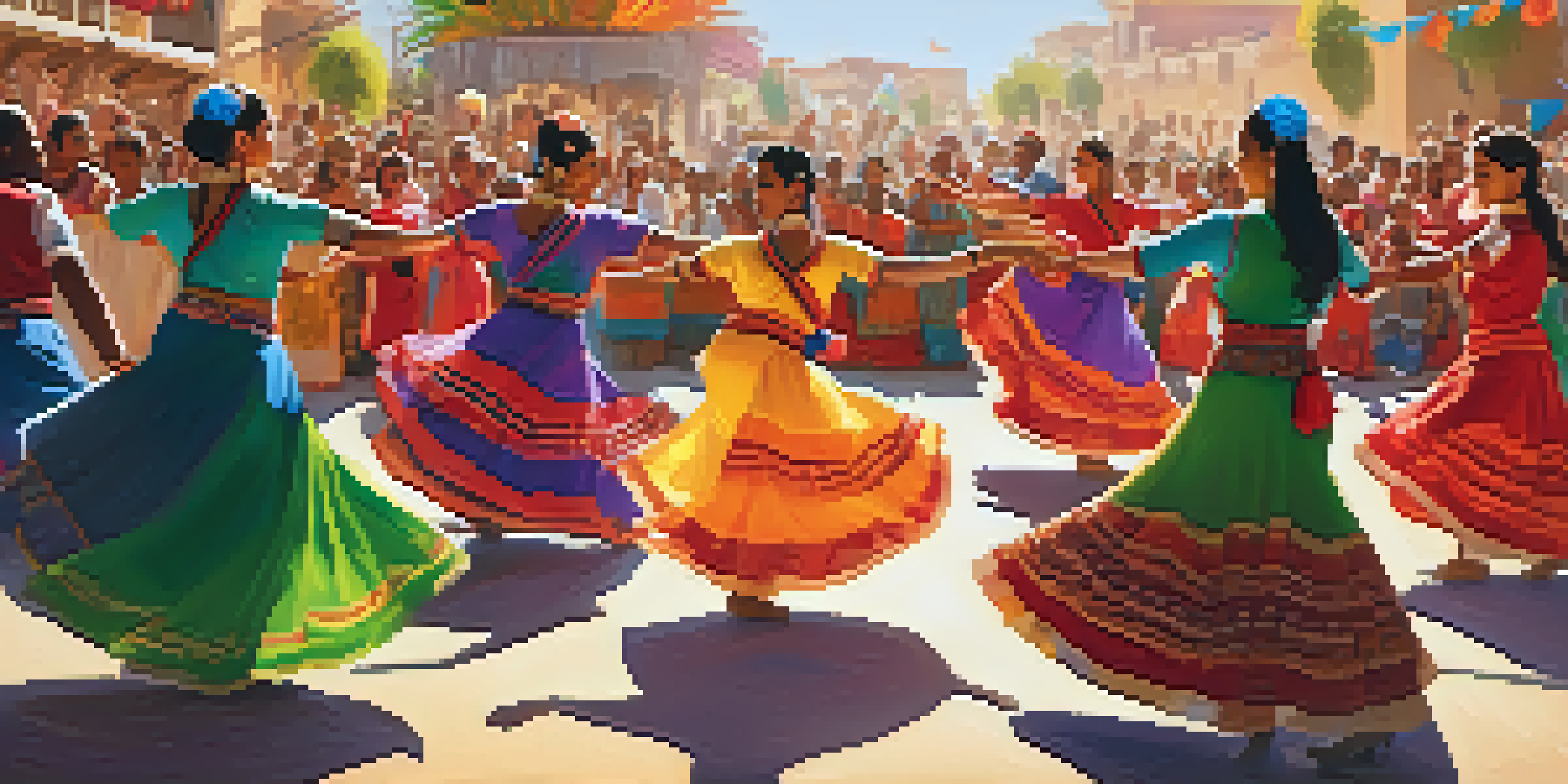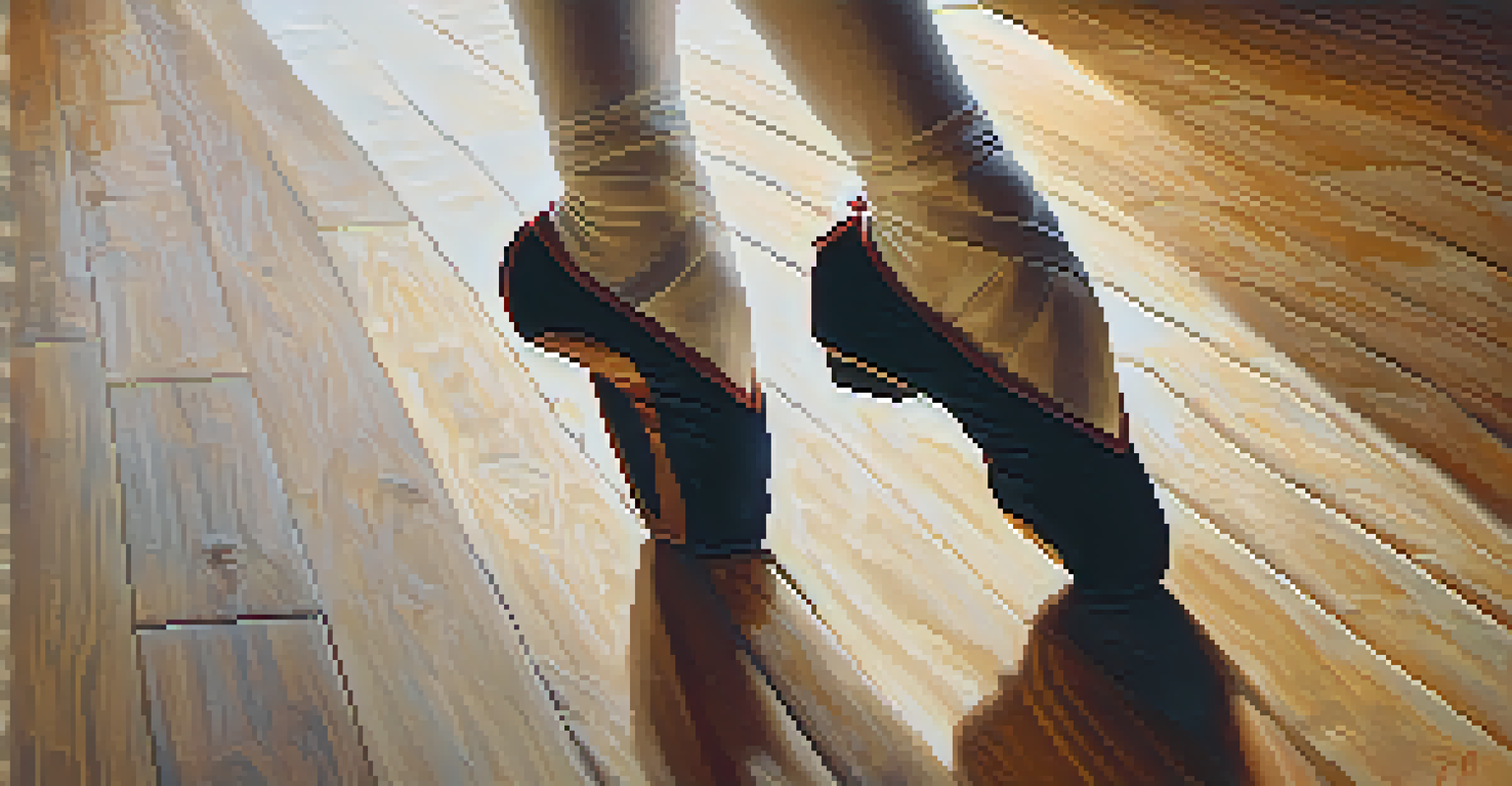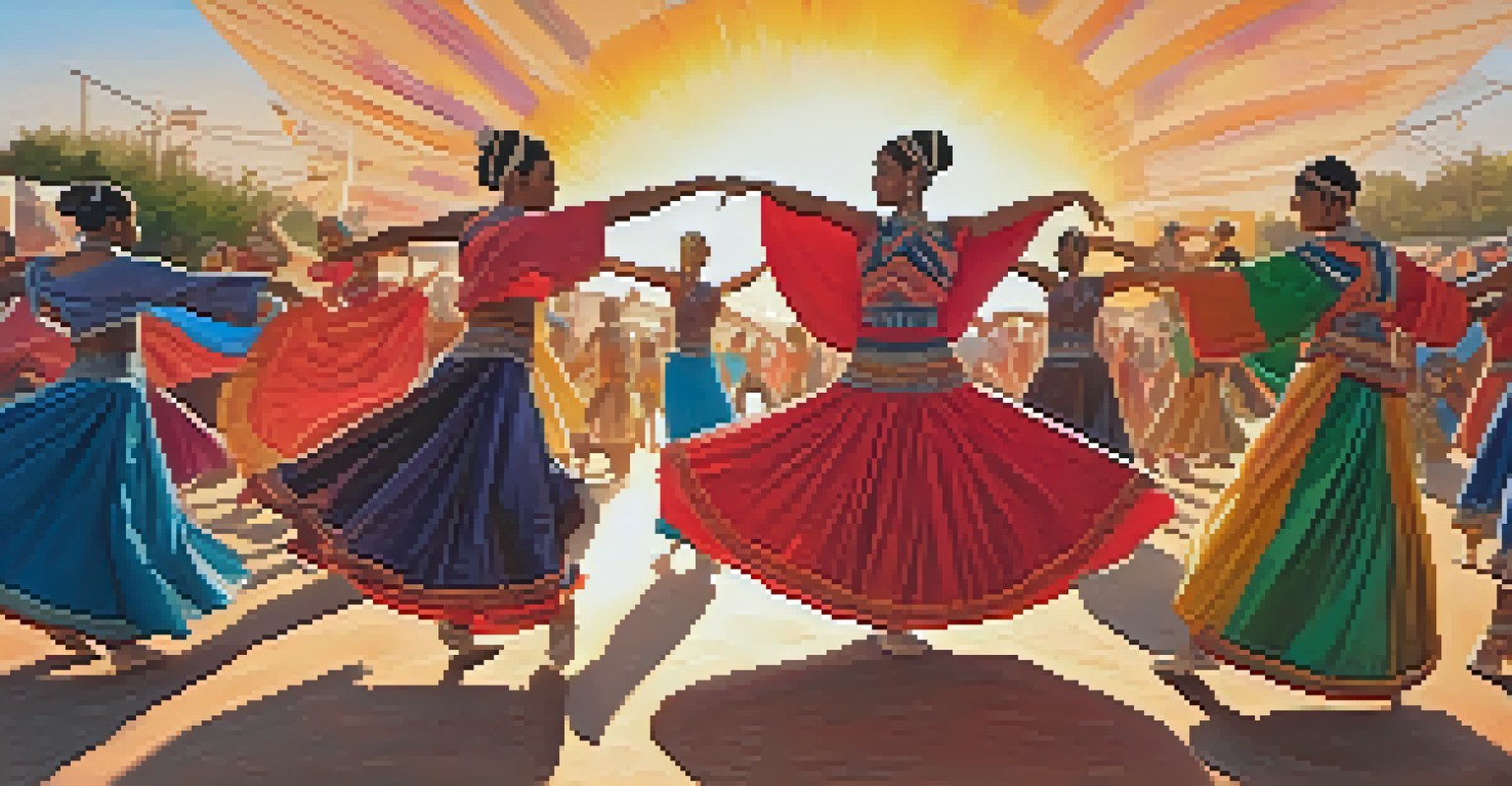Cultural Dance Festivals: Celebrating Heritage Through Movement

The Rich Tapestry of Cultural Dance Festivals
Cultural dance festivals are vibrant celebrations that showcase the diverse heritage of communities around the world. These events bring together people from various backgrounds, united by the joy of movement and expression. Whether it’s the rhythmic beats of a traditional drum or the graceful flow of a ballet, each dance tells a unique story steeped in culture and history.
Dance is the hidden language of the soul.
These festivals often feature a variety of performances, highlighting different styles and traditions. From the lively dances of African tribes to the elegant movements of classical Indian dance, participants and spectators alike are treated to an immersive experience. It’s not just about watching; many festivals encourage audience participation, allowing everyone to join in the celebration.
Moreover, cultural dance festivals serve as a platform for preserving and promoting heritage. In an ever-globalizing world, these events remind us of the importance of maintaining our roots and passing down traditions from generation to generation. They create a sense of belonging and pride, reinforcing community ties through the universal language of dance.
The Benefits of Cultural Dance Festivals
Cultural dance festivals offer numerous benefits that extend beyond entertainment. For starters, they promote cultural awareness and appreciation, educating attendees about different traditions and practices. This exposure fosters a greater understanding and respect for diversity, which is crucial in today’s interconnected world.

Additionally, these festivals often support local economies by attracting tourism. Visitors flock to experience the vibrant displays of dance, which in turn boosts local businesses such as restaurants, hotels, and shops. This economic impact can be significant, particularly for smaller communities looking to showcase their culture on a larger stage.
Cultural Dance Festivals Unite Us
These festivals celebrate diverse heritages, fostering community bonds through the joy of dance and shared experiences.
Lastly, the communal aspect of these festivals nurtures social bonds among participants and spectators. People come together to celebrate their heritage, creating lasting friendships and connections. The shared experience of dance can forge a sense of unity that transcends individual differences, making these festivals a powerful force for community building.
Dance as a Reflection of Identity
Dance is a profound form of expression that reflects individual and collective identities. Each movement, rhythm, and costume is imbued with cultural significance, telling stories of ancestry, struggles, and triumphs. Festivals become a canvas where these narratives are painted through the art of movement.
The dance is a poem of which each movement is a word.
For many dancers, participating in these festivals is a way to honor their heritage and keep traditions alive. It’s not uncommon to see generations of families involved, passing down skills, stories, and the love of dance. This intergenerational connection is a beautiful testament to the power of cultural expression.
Moreover, dance allows for personal interpretation of cultural stories, enabling artists to infuse their unique perspectives while honoring traditional forms. This blend of heritage and personal artistry creates a rich tapestry that evolves over time, ensuring that cultural dances remain relevant and vibrant.
Highlighting Global Dance Traditions
Around the globe, there are countless dance traditions that shine at cultural festivals. From the spirited Flamenco of Spain to the intricate Maori Haka of New Zealand, each dance form embodies the essence of its community. These performances provide a glimpse into the values, beliefs, and histories that shape different cultures.
Festivals often include workshops and demonstrations, giving attendees the chance to learn about these diverse dance styles firsthand. This interactive element not only enriches the festival experience but also inspires a new generation of dancers to explore their cultural roots. It’s a beautiful cycle of learning and sharing that keeps traditions alive.
Economic and Social Benefits
Cultural dance festivals boost local economies and nurture social connections, bringing communities together while promoting cultural awareness.
Additionally, many festivals feature competitions, showcasing the talent and creativity of performers. These contests encourage dancers to push their boundaries, innovate, and even blend different styles. The result is a dynamic showcase that captivates audiences and highlights the evolving nature of cultural dance.
Cultural Exchange Through Dance
Cultural dance festivals are a melting pot of traditions, often featuring performances from various cultures side by side. This unique setting fosters cultural exchange, allowing artists and audiences to learn from one another. It’s a celebration of diversity that emphasizes shared humanity through the language of dance.
As dancers collaborate across cultures, they create new forms and styles that reflect a fusion of influences. This blending of traditions can lead to innovative performances that resonate with wider audiences. It showcases how dance can transcend borders, making it a powerful tool for cultural dialogue.
Moreover, these exchanges can spark lifelong friendships and collaborations among artists. When dancers from different backgrounds come together, they share not just techniques but also stories and experiences, enriching their craft. This interconnectedness is what makes cultural dance festivals a truly transformative experience.
The Role of Technology in Dance Festivals
In recent years, technology has played a significant role in enhancing cultural dance festivals. From live streaming performances to using social media for promotion, technology helps to reach a larger audience. This visibility allows for greater appreciation and support for diverse dance traditions.
Moreover, technology can facilitate virtual participation, enabling dancers from around the world to showcase their talents without geographical limitations. Online platforms can host virtual festivals, allowing for global collaboration and exchange. This adaptability is crucial in a world where travel restrictions can impact cultural gatherings.
Dance Reflects Identity and Heritage
Through movement and performance, dance festivals honor cultural narratives, allowing for personal expression and intergenerational connections.
Additionally, technology aids in the preservation of dance forms through documentation. High-quality recordings of performances can capture the intricate details of dances, ensuring that future generations can study and appreciate these art forms. This blend of tradition and technology ensures that cultural dance continues to thrive.
The Future of Cultural Dance Festivals
As we look to the future, cultural dance festivals are likely to evolve while retaining their core essence. The continued emphasis on inclusivity and diversity will shape the way these festivals are organized and experienced. It’s essential to create spaces where all voices can be heard and celebrated.
Sustainability is also becoming a focal point for future festivals. Organizers are increasingly mindful of their environmental impact, seeking ways to minimize waste and promote eco-friendly practices. This shift aligns with the growing awareness of climate change and the responsibility of communities to nurture their surroundings.

Finally, the integration of education into these festivals will continue to play a vital role. Workshops, discussions, and performances that educate attendees about the cultural significance of dance will ensure that future generations appreciate and engage with their heritage. In this way, cultural dance festivals will remain a vital celebration of identity and community.